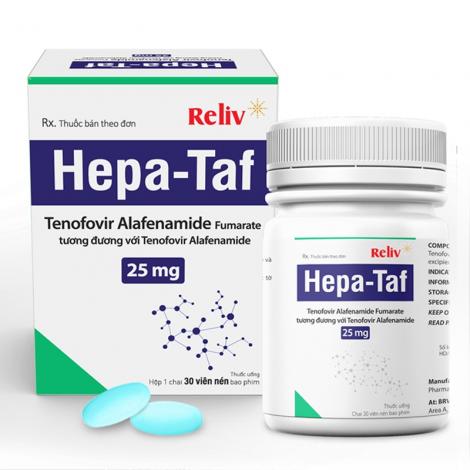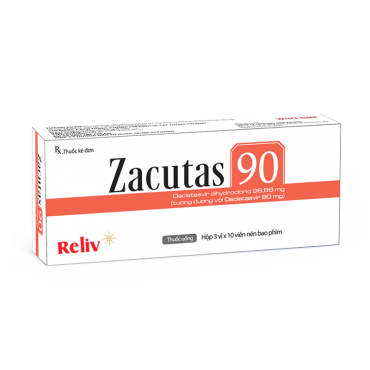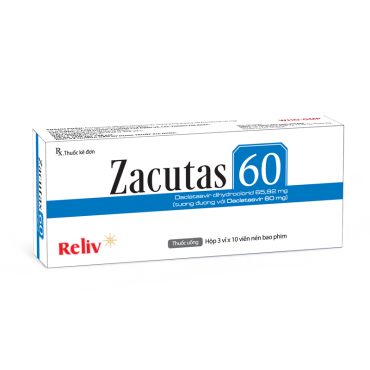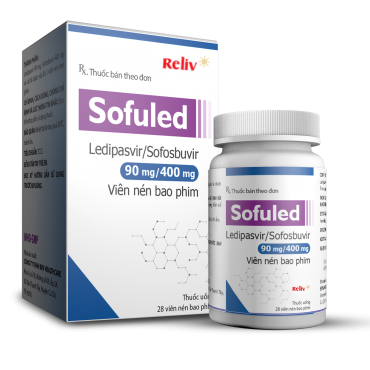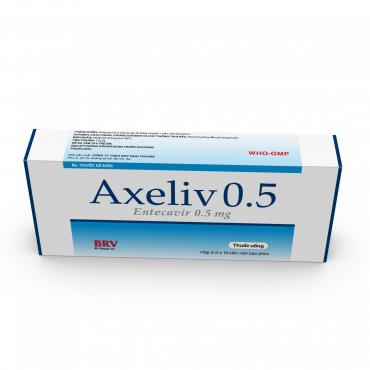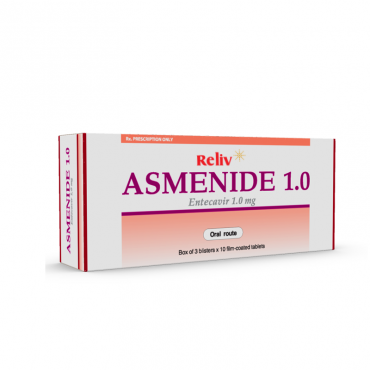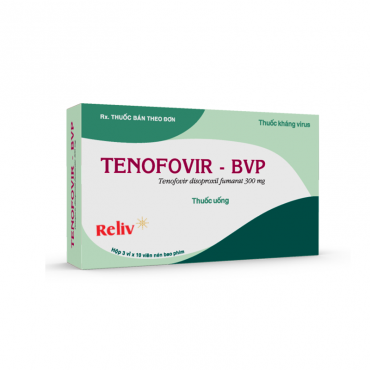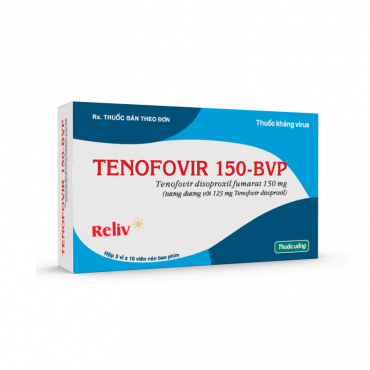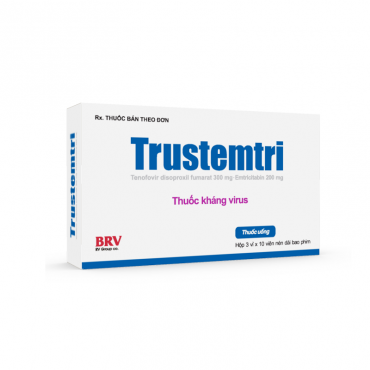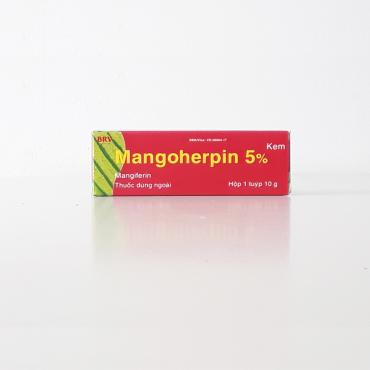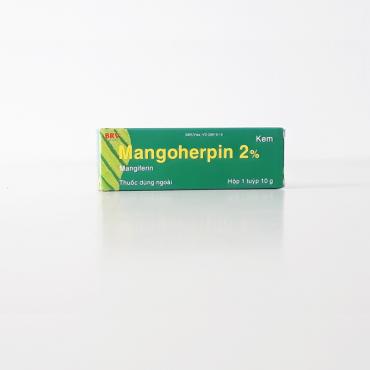Method of administration: Oral administration. Hepa-Taf film-coated tablets should be taken with food.
Posology: Therapy should be initiated by a physician experienced in the management of chronic hepatitis B.
Adults and paediatric patients at least 12 years of age and older weighing at least 35 kg: one tablet once daily.
Treatment discontinuation
Treatment discontinuation may be considered as follows:
• In HBeAg-positive patients without cirrhosis, treatment should be administered for at least 6-12 months after HBe seroconversion (HBeAg loss and HBV DNA loss with anti-HBe detection) is confirmed or until HBs seroconversion or until there is loss of efficacy. Regular reassessment is recommended after treatment discontinuation to detect virological relapse.
• In HBeAg-negative patients without cirrhosis, treatment should be administered at least until HBs seroconversion or until there is evidence of loss of efficacy. With prolonged treatment for more than 2 years, regular reassessment is recommended to confirm that continuing the selected therapy remains appropriate for the patient.
Missed dose
If a dose is missed and less than 18 hours have passed from the time it is usually taken, the patient should take Hepa-Taf as soon as possible and then resume their normal dosing schedule. If more than 18 hours have passed from the time it is usually taken, the patient should not take the missed dose and should simply resume the normal dosing schedule.
If the patient vomits within 1 hour of taking Hepa-Taf, the patient should take another tablet. If the patient vomits more than 1 hour after taking Hepa-Taf, the patient does not need to take another tablet.
Special populations
Elderly
No dose adjustment of Hepa-Taf is required in patients aged 65 years and older.
Renal impairment
No dose adjustment of Hepa-Taf is required in adults or adolescents (aged at least 12 years and of at least 35 kg body weight) with estimated creatinine clearance (CrCl) ≥ 15 mL/min or in patients with CrCl < 15 mL/min who are receiving haemodialysis.
On days of haemodialysis, Hepa-Taf should be administered after completion of haemodialysis treatment.
No dosing recommendations can be given for patients with CrCl < 15 mL/min who are not receiving haemodialysis.
No data are available to make dose recommendations in children aged less than 12 years and of less than 35 kg body weight with renal impairment.
Hepatic impairment
No dose adjustment of Hepa-Taf is required in patients with hepatic impairment.
Paediatric population
The safety and efficacy of Hepa-Taf in children younger than 12 years of age or weighing < 35 kg have not yet been established. No data are available.
HBV transmission
Patients must be advised that Hepa-Taf does not prevent the risk of transmission of HBV to others through sexual contact or contamination with blood. Appropriate precautions must continue to be used.
Patients with decompensated liver disease
There are limited data on the safety and efficacy of Hepa-Taf in HBV infected patients with decompensated liver disease and who have a Child Pugh Turcotte (CPT) score > 9 (i.e. class C). These patients may be at higher risk of experiencing serious hepatic or renal adverse reactions. Therefore, hepatobiliary and renal parameters should be closely monitored in this patient population.
Exacerbation of hepatitis
Flares on treatment
Spontaneous exacerbations in chronic hepatitis B are relatively common and are characterised by transient increases in serum alanine aminotransferase (ALT). After initiating antiviral therapy, serum ALT may increase in some patients. In patients with compensated liver disease, these increases in serum ALT are generally not accompanied by an increase in serum bilirubin concentrations or hepatic decompensation. Patients with cirrhosis may be at a higher risk for hepatic decompensation following hepatitis exacerbation, and therefore should be monitored closely during therapy.
Flares after treatment discontinuation
Acute exacerbation of hepatitis has been reported in patients who have discontinued treatment for hepatitis B, usually in association with rising HBV DNA levels in plasma. The majority of cases are self-limited but severe exacerbations, including fatal outcomes, may occur after discontinuation of treatment for hepatitis B. Hepatic function should be monitored at repeated intervals with both clinical and laboratory follow-up for at least 6 months after discontinuation of treatment for hepatitis B. If appropriate, resumption of hepatitis B therapy may be warranted.
In patients with advanced liver disease or cirrhosis, treatment discontinuation is not recommended since post-treatment exacerbation of hepatitis may lead to hepatic decompensation. Liver flares are especially serious, and sometimes fatal in patients with decompensated liver disease.
Renal impairment
Patients with creatinine clearance < 30 mL/min
The use of Hepa-Taf once daily in patients with CrCl ≥ 15 mL/minute but < 30 mL/minute and in patients with CrCl <15 mL/min on hemodialysis based on only very limited pharmacokinetic data. There are limited data on the safety and efficacy of Hepa-Taf in HBV-infected patients with CrCl < 30 mL/min.
The use of Hepa-Taf is not recommended in patients with CrCl < 15 mL/min who are not receiving haemodialysis.
Nephrotoxicity
A potential risk of nephrotoxicity resulting from chronic exposure to low levels of tenofovir due to dosing with tenofovir alafenamide cannot be excluded.
Patients co-infected with HBV and hepatitis C or D virus
There are no data on the safety and efficacy of Hepa-Taf in patients co-infected with hepatitis C or D virus. Co-administration guidance for the treatment of hepatitis C should be followed.
Hepatitis B and HIV co-infection
HIV antibody testing should be offered to all HBV infected patients whose HIV-1 infection status is unknown before initiating therapy with Hepa-Taf. In patients who are co-infected with HBV and HIV, Hepa-Taf should be co-administered with other antiretroviral agents to ensure that the patient receives an appropriate regimen for treatment of HIV.
Co-administration with other medicinal products
Hepa-Taf should not be co-administered with medicinal products containing tenofovir alafenamide, tenofovir disoproxil (TDF) or adefovir dipivoxil.
Co-administration of Hepa-Taf with certain anticonvulsants (e.g. carbamazepine, oxcarbazepine, phenobarbital and phenytoin), antimycobacterials (e.g. rifampicin, rifabutin and rifapentine) or St. John's wort, all of which are inducers of P-glycoprotein (P-gp) and may decrease tenofovir alafenamide plasma concentrations, is not recommended.
Co-administration of Hepa-Taf with strong inhibitors of P-gp (e.g. itraconazole and ketoconazole) may increase tenofovir alafenamide plasma concentrations. Co-administration is not recommended.
Lactose intolerance
Hepa-Taf contains lactose monohydrate. Patients with rare hereditary problems of galactose intolerance, total lactase deficiency or glucose-galactose malabsorption should not take this medicinal product.

